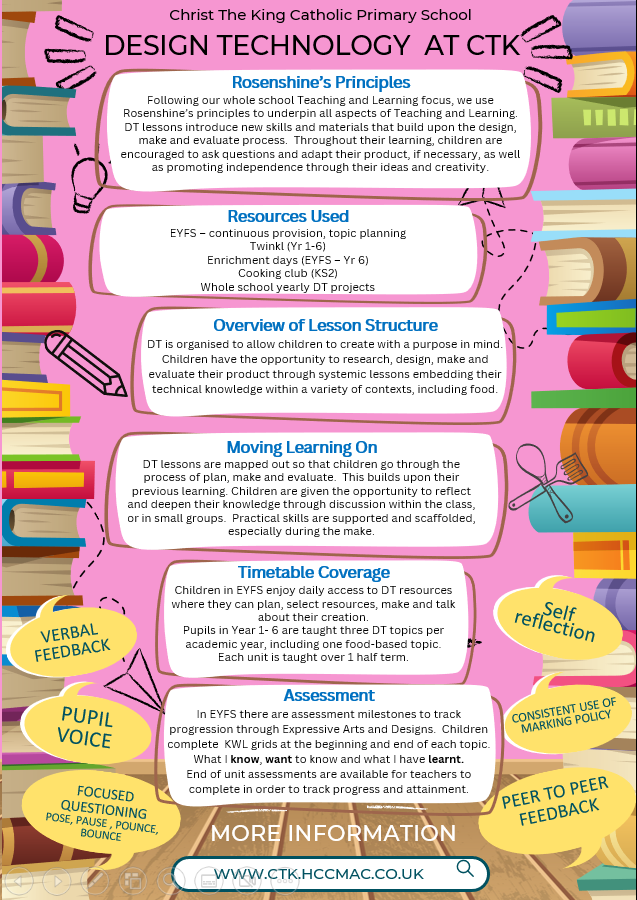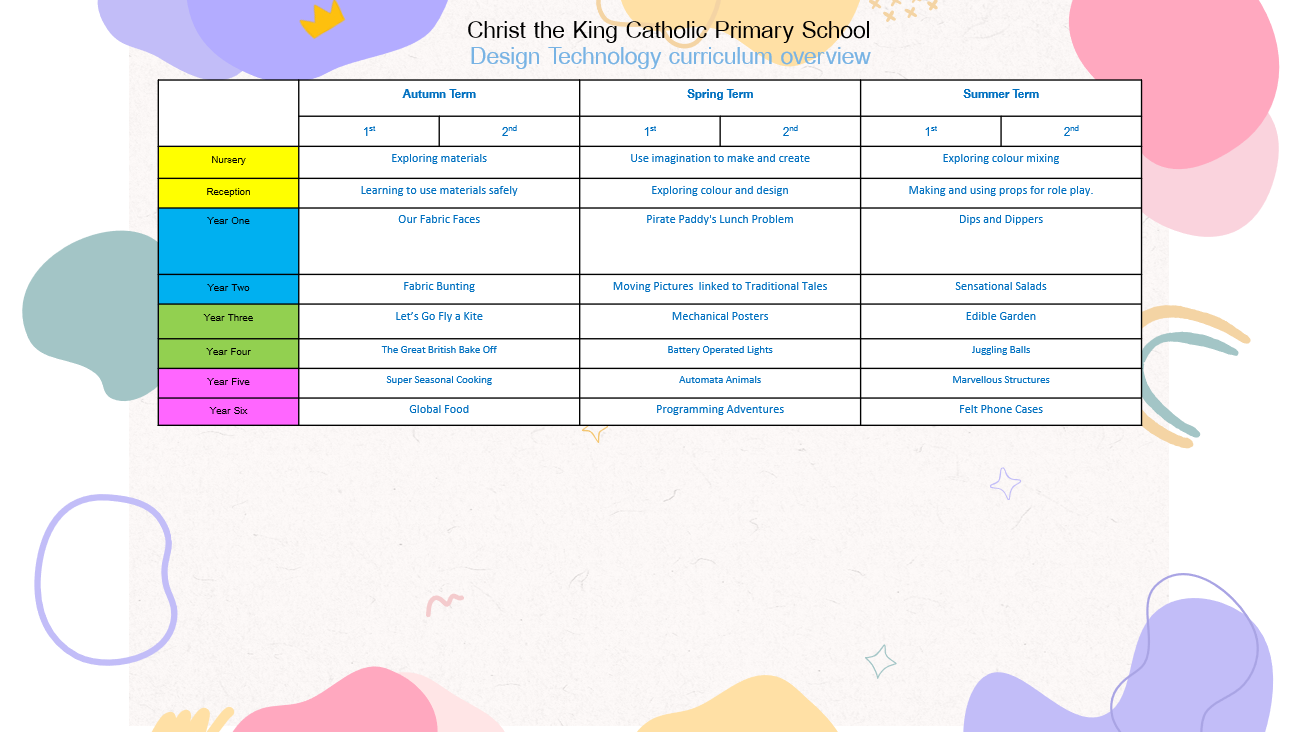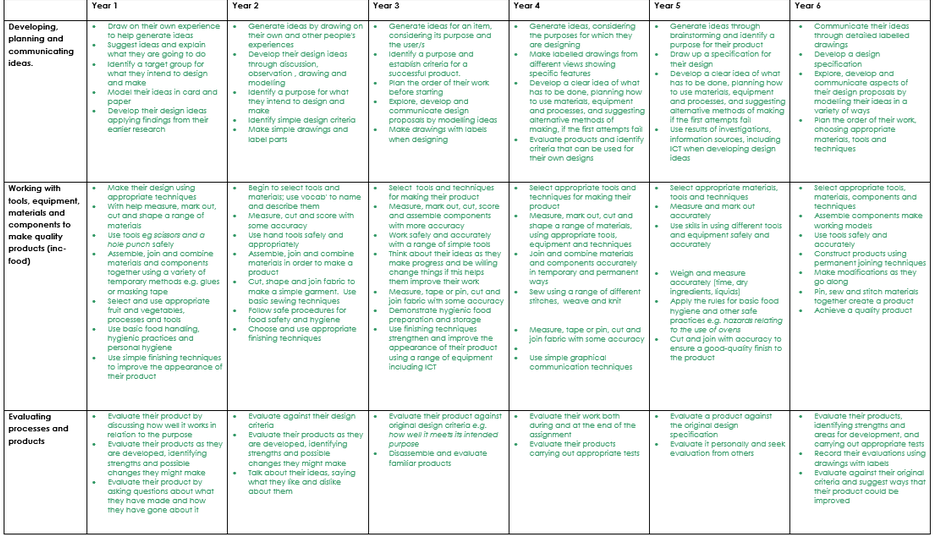We believe it is vital that every pupil at Christ The King is given robust opportunities to develop the strengths and techniques which will allow them to reach their fullest potential. Within the Design and Technology curriculum we must equip our children with the opportunities to develop lifelong skills whilst also developing a sense of awe and wonder when recognising how they themselves can be part of a design and evaluation process which can give solutions to real life situations and can do this with confidence.
Design and Technology is a way of learning, which spans and links the whole curriculum. In primary school it is rooted within imaginative play, art and science. We want all children at Christ The King to think innovatively, to question and explore the practical world around them and to develop a positive, growth mind-set approach to their learning
Children should be excited and engaged with the activities and opportunities on offer. As part of the curriculum and these should support and develop the whole child , giving every child the chance to ……
- learn to think and intervene creatively to solve problems, both as individuals and as part of a team;
- develop the creative, technical and practical expertise needed to perform everyday tasks confidently and to participate successfully in an increasingly technological world;
- build and apply a repertoire of knowledge, understanding and skills in order to design and make high-quality products;
- select appropriate tools and techniques with increasing accuracy for making a product, whilst following safe procedures;
- critique, evaluate and test their ideas and products and the work of others;
- reflect on and evaluate present and past design and technology, its uses and its impact;
- use computing to assist designing and making;
- apply the principles of nutrition and learn how to cook.
Design & Technology at ctk

Overview of Curriculum

Intent Document
|
EYFS National Expectations |
|
Expressive Arts and Design (Exploring and Using Media and Materials) Children safely use and explore a variety of materials, tools and techniques, experimenting with colour, design, texture, form and function.
Expressive Arts and Design (Being Imaginative) Children use what they have learnt about media and materials in original ways, thinking about uses and purposes. They represent their own ideas, thoughts and feelings through design and technology, art, music, dance, role play and stories.
Physical Development (Moving and Handling) Children handle equipment and tools effectively, including pencils for writing. |
|
KS1 National Expectations |
|
Design Pupils should be taught to:
Make Pupils should be taught to:
Evaluate Pupils should be taught to:
evaluate their ideas and products against design criteria
Technical Knowledge Pupils should be taught to:
Cooking and Nutrition Pupils should be taught to:
understand where food comes from. |
|
KS2 National Expectations |
|
Design Pupils should be taught to:
Make Pupils should be taught to:
Evaluate Pupils should be taught to:
Technical Knowledge
Cooking and Nutrition Pupils should be taught to:
understand seasonality, and know where and how a variety of ingredients are grown, reared, caught and processed. |
Intent |
|
At Christ the King, Design and Technology offers a coherently planned sequence of lessons to help teachers and pupils ensure they have progressively covered the knowledge, understanding and skills required in the National Curriculum. The Design and Technology units aim to inspire children through a broad range of practical experiences to create innovative designs which solve real and relevant problems within a variety of different contexts. This design process encourages children to identify real and relevant problems, critically evaluate existing products and then take risks and innovate when designing and creating solutions to the problems. As part of the design process, time is built in to reflect, evaluate and improve on prototypes using design criteria throughout to support this process. Opportunities are provided for children to evaluate key events and individuals who have helped shape the world, showing the real impact of design and technology on the wider environment and helping to inspire children to become the next generation of innovators. |
Implementation |
|
At Christ the King, Design and Technology skills and understanding are built into lessons. The units allow for the revision of ideas to become part of good practice and ultimately helps to build a depth to children's understanding. Through revisiting and consolidating skills, our lesson plans and resources help children build on prior knowledge alongside introducing new skills, knowledge and challenge. We suggest a specific series of lessons for each key stage, which offer structure and narrative but are by no means to be used exclusively, rather to support planning. The revision and introduction of key vocabulary is built into each lesson. This vocabulary is then included in display materials and additional resources to ensure that children are allowed opportunities to repeat and revise this knowledge. Adult guides and accurate design and technology subject knowledge are always provided within lessons to allow the teacher working in those lessons to feel confident and supported with the skills and knowledge that they are teaching. Through these lessons, we intend to inspire pupils and practitioners to develop a love of Design and Technology and see how it has helped shaped the ever-evolving technological world they live in. |
Impact |
|
The impact of using the full range of resources, including display materials, will be seen across the school with an increase in the profile of Design and Technology. The learning environment across the school will be more consistent with design and technology technical vocabulary displayed, spoken and used by all learners. Whole-school and parental engagement will be improved through the use of design and technology-specific home learning tasks and opportunities suggested in lessons and overviews for wider learning. We want to ensure that Design and Technology is loved by teachers and pupils across school, therefore encouraging them to want to continue building on this wealth of skills and understanding, now and in the future. Impact can also be measured through child-led assessment and key questioning aimed at targeting next steps in learning. |
Progression of Skills

Useful Links

